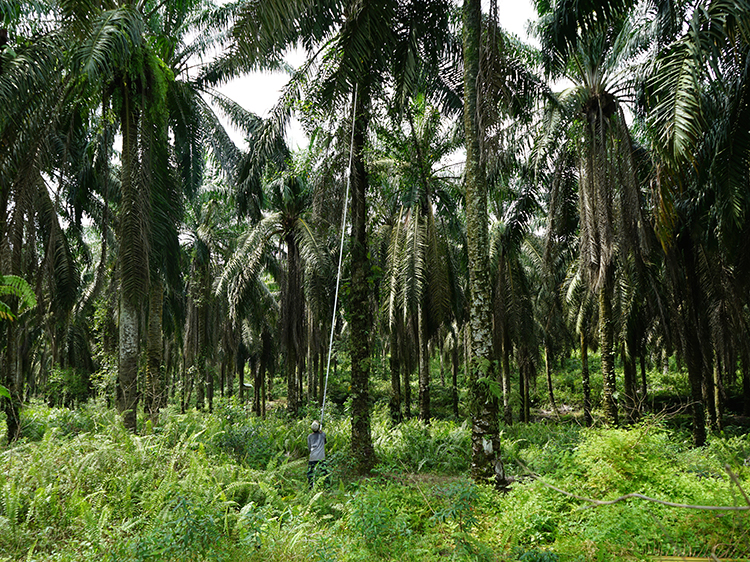
A journey through agro-industrial territories of palm oil production in Southeast Asia
– Hans Hortig
In 2015 a group of anthropologists proposed the concept of the Plantationocene1 to describe the current practice of agrarian production and the alienation of plants, property, and labour, joining a long list of “-cene’s” which recently try to frame processes of human/non-human entanglement (Chthulucene), the role of humans as a geomorphological agency (Anthropocene) or the dominance and influence of capitalism (Capitalocene). While all of these concepts capture crucial elements of contemporary worlding, the Plantationocene’s focus on modes of capitalist agrarian production implies a valuable spatial perspective intrinsic to architectural and landscape architectural practices. Although products such as sugar, palm oil, soy, and cotton are ubiquitous, the circumstances of production and their spatial effects—from territories of extraction to spaces of trade and accumulation—are largely understudied in the field of architecture and urban studies.
In the case of palm oil, the socio-ecological impacts of the expanding plantation landscapes are discussed in social and environmental science research2—mainly focusing on “frontier” landscapes—but the spaces of production and circulation are not subject of architectural and landscape architectural research. During the last decades, design disciplines neglected territories of extraction and circulation by focusing on cities and large urban agglomerations, thus surrendering infrastructural and agrarian spaces to the realm of economic and environmental engineering. Challenging this city-centrism3 of architectural and landscape architectural research and design could enable a productive dialogue across disciplines that engages with territories of extraction and distribution of resources.
The proposed research asks: What is the role of architects and landscape architects in the transformation of operationalized territories of agro-industrial palm oil production? How do people inhabit and traverse those landscapes? What are the spatial dimensions of the palm oil supply chain and what are the vectors of spatial transformation in contemporary production landscapes?
The following photographic essay documents phenomena encountered during a scoping research trip through Peninsular Malaysia — from Kuala Lumpur to Singapore. It aims to collect initial research questions and raise curiosity about the future of a long-standing palm oil plantation landscape.
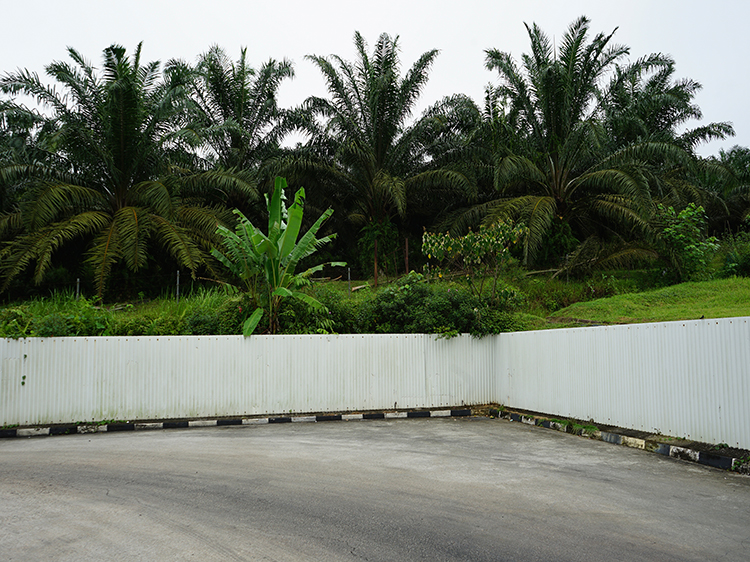
1. A row of palm trees at a gas station along the highway between Kuala Lumpur and Singapore. Hentian Sebelah Kulai South Bound, Malaysia.
Driving for six hours between Kuala Lumpur and Singapore, one can’t see anything other then palm trees. Theoretically, there are more than 50,000 trees planted at an equal distance of eight meters lining the highway.
The palm trees along the highway are not ornamental trees planted in one line: The endless sea of spiky trees expands uninterruptedly in offset rows till the horizon. Like modern land surveyors, they seem to measure the territory by triangulation. Bio-monotony as far as the eye can see.
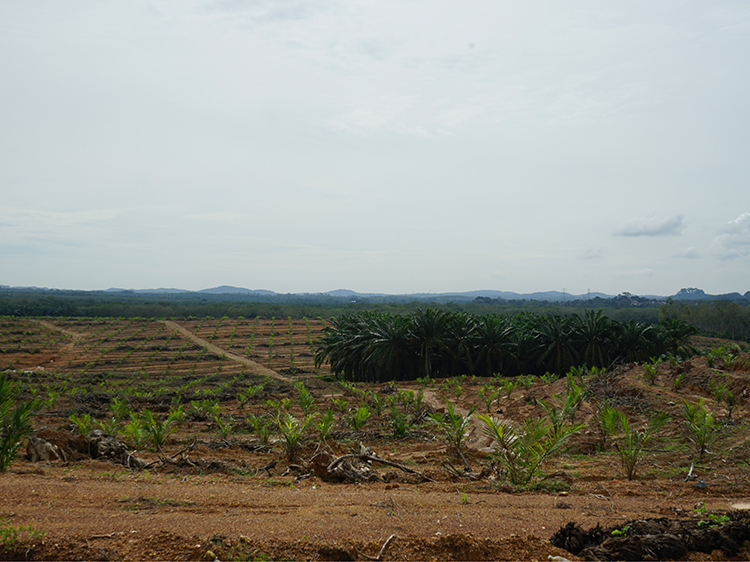
2. Partial replanting of a palm oil estate in the most economical 8×8 meter grid. Segamat, Malaysia.
Since the early British colonization of Peninsular Malaysia, the agrarian sector has been dominated by large scale plantations. This type of agrarian production proved to be particularly useful in expanding the colonial project by utilizing land while simultaneously securing power over land, labour, and export-oriented resource production. As colonial exploitation machines, the plantations transferred the logic of the factory to the landscape. Standardization, clearly defined procedures within the production process, and the measurability of output and yield were directly translated into the logic of agricultural production.
After the Malaysian state emerged after several years of struggle for independence, the plantation system was appropriated by the newly found nation-state, and, due to the declining demand for natural rubber, most of the Hevea trees (rubber) were replaced by the African Palm4. Artist Simryn Gill strikingly summaries the history of the plantation landscape in peninsular Malaysia: “How many of us are left who knew this landscape before there were plantations, or estates, as we call them? In my time they’ve never not been here.”5

3. Indonesian migrant worker harvesting fresh fruit bunches with a 12-meter-long rod. Johor State, Malaysia.
Triggered by the universal application of palm oil and its features as a “flex crop”6, plantations expanded across the Malay world from the 1970s onward. This time, neo-colonial international institutions facilitated and promoted the “development crop” in tandem with the newly found nation-states. Today, Indonesia and Malaysia dominate the production statistics, producing more than 80% of the global crude palm oil covering an area of 200,000 square kilometers—roughly the size of the whole island of Great Britain.
During the second half of the 20th and the early 21st century, palm oil production expanded at an unprecedented scale, mainly at the expense of the indigenous forest. The sea as socio-economic space was replaced by land: Fisherman became farmers inhabiting the territories of palm oil production. Fishing rods are replaced by extendable sticks, equipped with saw blades, long enough to cut the fresh fruit bunch from the top of the oil palm.
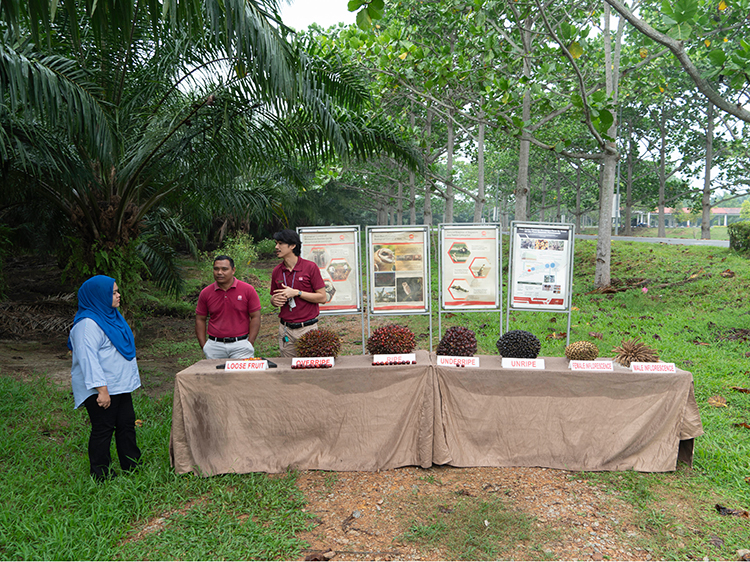
4. Staff members present the palm oil fruit development, plant pruning, and biological pest control at Sime Darby Palm Oil Experience Centre, Carey Island, Malaysia.
Inside the territories of agro-industrial production, the estate becomes the essential unit to quantify efficiency by measuring fertilizer input, labour, and yield. The plantation-as-factory system, equipped with a palm oil mill, becomes a territorial infrastructure that subordinates every other land use.7 The oil palm is just too lucrative to plant anything else.
Ripe fruits are picked and delivered to the mill where the oil is extracted within 24 hours, otherwise they go rancid. With a catchment radius of 50 kilometers, the mill dominates the landscape, and smallholders in the area start to shift cultivation to participate in the export economy.
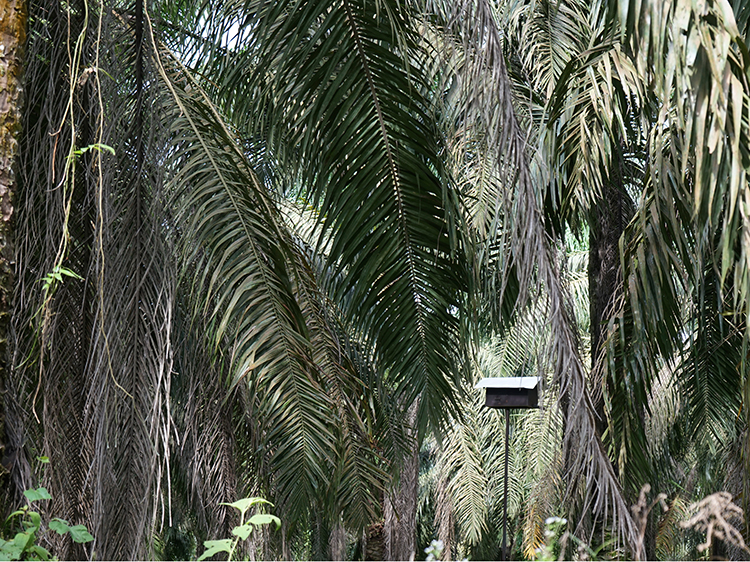
5. Owl barn as architectural element in a palm oil plantation. Johor State, Malaysia.
Once in a while, there are huts to house owls, who eat the rats, who like—and therefore feed on—palm fruits. Managers call this biological pest control. As part of sustainable management strategies, this practice was invented in tandem with sustainable certificates to calm increasing criticisms on farming practices. The certification industry became a crucial marketing tool that simultaneously enabled the expansion of production—creating sustainable territories through a complex layering of regulatory authority.
Since the majority of consumers are decoupled from the production of palm oil, the certification industry underpins a commodity fetish with a purposeful externalization of production. The black box of production and circulation is labelled “green” but simultaneously remains uncharted.
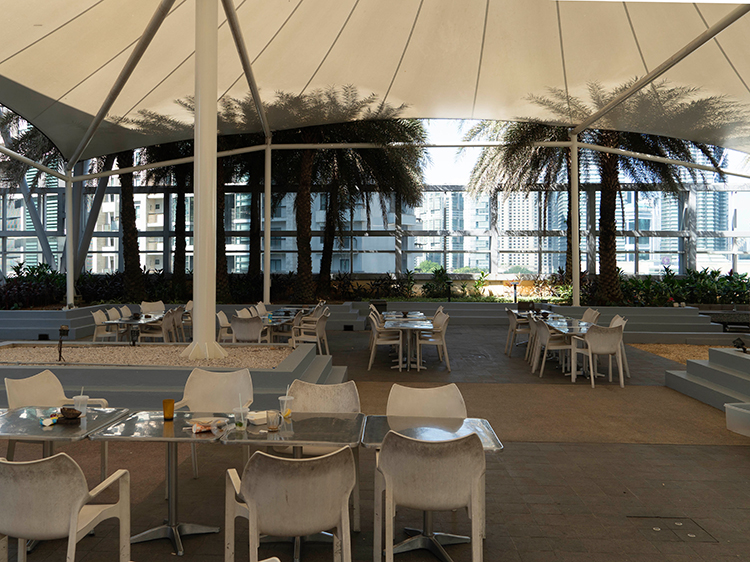
6. Oil palms used as design element at the FELDA Employee’s Canteen. FELDA Tower, Kuala Lumpur.
Through estates and mills, land is rendered investable for conglomerates of transnational companies often backed by local, political elites. In Kuala Lumpur, Singapore and Jakarta palm dollars accumulate and crystallize in the form of office towers, research institutes, and stock exchange buildings. In those spaces of ultimate commodification of nature, the palm tree becomes reduced to a scenic backdrop, reminiscent of the tropical region it inhabits. As an urban reflection of industrial agriculture, these architectures need to be conceptualized together with the hinterlands and territories of extraction that they operate and design.
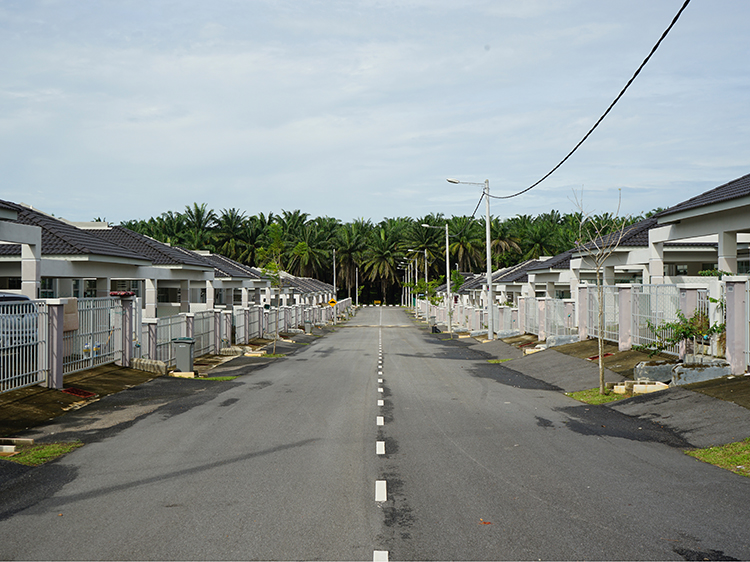
A housing estate developed on—and entirely surrounded by—palm oil plantations. Johor State, Malaysia.
Most of the palm oil producing companies operate real estate development companies too. Land is traded between subsidiary companies to extract primary products or developed housing estates. Over the years, companies have learned how to turn plantations into housing estates.
If there are houses, they are built on palm oil estates. The newly found administrative center of Malaysia, Putrajaya, was built on a palm oil estate in 1995. The site where the Indonesian president is planning to relocate the capital city and governmental offices from Jakarta is also full of palms. To cite Simryn Gill again, “Where there were rows of trees, there are now sprouting new towns, oil palm estates are becoming housing estates.”
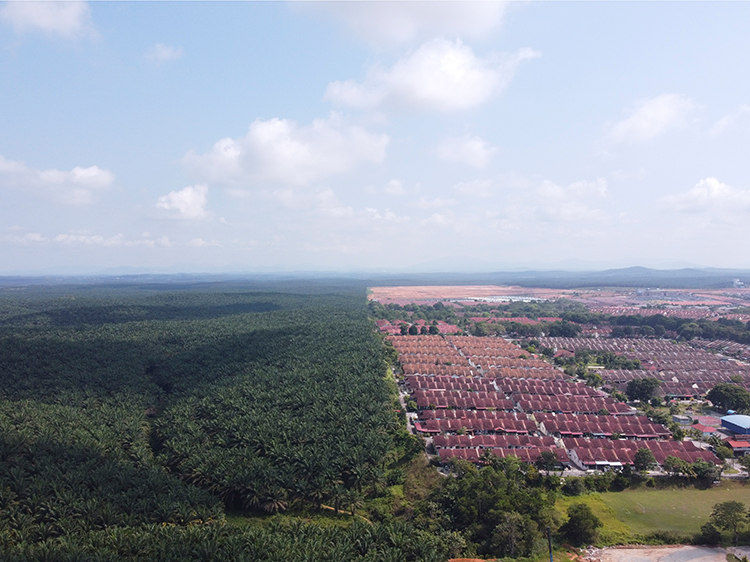
8. The expansion of the Bandar Putra Housing Estate on the adjacent plantations is scheduled for 2022. Kulai, Malaysia.
Throughout the 20th century, design disciplines have been concerned with projecting a productive entanglement of urban environments and agriculture by envisioning crucial infrastructures, settlement patterns, and production typologies.8 In doing so, design played a crucial role in facilitating the synthesis of interdisciplinary knowledge and ideas. After celebrating the Urban Age as a city-centric project, design disciplines are returning to investigate the other ninety eight percent of the earth’s surface.9
Looking at the palm oil plantation landscape between Kuala Lumpur and Singapore triggers further research into the palm oil supply chain and its spatial implications.
How did palm oil production operationalise the landscape of Peninsular Malaysian? What are the spaces and landscapes incorporated in the palm oil supply chain and what are the vectors of spatial transformation in contemporary production landscapes?
Notes
1.Haraway, D., Noboru, I., Scott, F. G., Kenneth, O., Tsing, A., and Bubandt, N. (2016). Anthropologists are talking – about the anthropocene. ethnos, 81:3, pp. 535-564.
2. See for example:
Cramb, R. A., and McCarthy, J.F. eds. (2016). The Oil Palm Complex: Smallholders, Agribusiness and the State in Indonesia and Malaysia. Singapore: NUS Press.
Fitzherbert, E.B., M. Struebig, A. Morel et al. (2008). “How will oil palm expansion affect biodiversity?” Trends in Ecology & Evolution, 23(10), pp.538-545.
Pye, O. and Bhattacharya, J. eds. (2013). The palm oil controversy in Southeast Asia: a transnational perspective. Singapore: ISEAS.
3. Cairns, S. (2018). Debilitating city-centricity: Urbanisation and urban-rural hybridity in Southeast Asia. In: Routledge Handbook on Urbanisation in Southeast Asia, ed. Rita Padawangi. London: Routledge.
4. Taussig, M. (2018). Palma Africana. Chicago: University of Chicago Press.
5. Gill, S. (2018). Becoming Palm. Singapore: NTU Centre of Contemporary Art and Sternberg Press 2017.
6. Flex crops are plants that can be processed into a variety of different products. They can be used as food, additives or fuel and are therefore suitable for an extremely wide range of applications.
7. Li, T. (2015). After the land grab: Infrastructural violence and the “Mafia System”. Indonesia’s oil palm plantation zones. In: Land grabbing, conflict and agrarian‐environmental transformations: perspectives from East and Southeast Asia. International academic conference, Chiang Mai University.
8. See for example the work by Konstantinos Doxiadis, Frank Lloyd Wright or Ian McHarg.
9. See for example the exhibition Countryside. A Report at the MOMA, New York or the exhibition Taking the Countries Side at EPFL Lausanne.
For a theoretical discourse on processes of extended urbanization that include agrarian territories or spaces of raw material extraction see:
Brenner, N., and Schmid, C. (2014). The “Urban Age” in Question. International Journal for Urban and Regional Research, 38(3) pp. 731-55.
Brenner, N., and Schmid, C. (2015). Towards a new epistemology of the urban?. City 19(2-3), pp. 151-82.
Diener, R., Herzog, J., Meili, M., De Meuron, P., Schmid, C. (2006). Switzerland: An Urban Portrait. Basel: Birkhäuser.
+
All photographs are taken by Hans Hortig on a research scoping trip between Kuala Lumpur and Singapore between the 22th and the 30th of September, 2019.
Hans Hortig studied landscape architecture at the TU Berlin, the ETH Zurich and the School of Design, Mysore. In 2013, he joined Architecture of Territory, Prof Topalovic, at the FCL Singapore and at the ETH Zurich where he taught design and research studios, organized lecture series and guided numerous student projects. In 2015, he co-founded the cartographic studio maps&more with Karoline Kostka and recently started his PhD research investigating processes of extended urbanization in Southeast Asian palm oil territories.
Volume 3, no. 3 Autumn 2020
